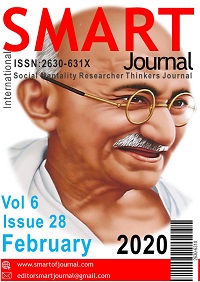Beden Eğitimi ve Spor Dersinde Eğitim Etkileşimleri ve Cinsiyet Farklılıklarının Öğrenci Algısına Etkisi Üzerine Bir Çalışma
Author :
Abstract
Okul, bireylerin cinsiyet rollerinin gelişmesinde ve cinsiyetlerinin kendi başına korunmasında güçlü bir etkiye sahiptir. Ayrıca, öğrencileri yalnızca standartlaşmış öğrenme durumları yoluyla değil, davranış kuralları, derslik düzenlemeleri ve öğretmenlerin kullandığı pedagojik yöntemler yoluyla da biçimlendirir, toplumsallaştırır. Bu çalışmada, beden eğitimi ve spor eğitimindeki cinsiyet farklılıklarına, özellikle öğretmen-öğrenci etkileşimleriyle öğrenci başarısını etkileyen faktörler incelenmektedir. Video gözlemlerine dayanan ilk aşama, konuyla ilgili önceki yapılan araştırmaları doğrulamak adına, erkek öğrencilerin öğretmenleriyle olan etkileşimlerinde öncelikli olarak tercih edilip edilmediğini göstermeyi amaçlamaktadır. Sonuçlar kısmen de olsa sayı ve süre bakımından erkeklerin etkileşimlerdeki avantajına ilişkin hipotezi doğrulamaktadır. İkinci aşamada ise, beden eğitimi öğretmenlerinin desteğiyle ilgili öğrenci memnuniyetini ölçmek için oluşturulan anketler öğrencilere uygulanmıştır. Sonuçlar, cinsiyetle ilişkili etkileşimlerdeki farklılıkların kız öğrencileri tarafından aynı şekilde algılanmadığını göstermektedir.
Keywords
Abstract
The school has a School has a strong influence on the development of gender roles of the individuals and the protection of their gender on its own. It also shapes and socializes students not only through standardized learning situations, but also through codes of conduct, classroom regulations, and pedagogical methods used by teachers. In this study, gender differences in physical education and sports education, especially teacher-student interactions and factors affecting student achievement are examined. The first phase, based on video observations, aims to show whether male students are preferred as a priority in their interactions with their teachers, in order to validate previous research on the subject. The results partly confirm the hypothesis of male's advantage in interactions in terms of number and duration. In the second phase, surveys were applied to the students to measure student satisfaction with the support of physical education teachers. The results show that differences in gender-related interactions are not perceived in the same way by female students.
Keywords
- Asan, H. T. (2010). Ders Kitaplarında Cinsiyetçilik ve Öğretmenlerin Cinsiyetçilik Algılarının
- Asan, H. T. (2010). Ders Kitaplarında Cinsiyetçilik ve Öğretmenlerin Cinsiyetçilik Algılarının Saptanması. Fe Dergi, 2 (2), 65-74.
- Cogerino, G. (2005). (sous la dir. de), Filles et garçons en EPS, Editions Revue EPS, Paris.
- Çetinkol, Ş. G. (2008). Türkiye’de eğitime farklı bir bakış açısı: Feminist pedagoji. Yüksek lisans tezi, İstanbul Üniversitesi Sosyal Bilimler Enstitüsü, İstanbul. 26-27.
- Durand-Delvigne, A. (1996). Confrontation inter-groupes de sexe et identité de genre: quelques effets du contexte scolaire, Revue Française de pédagogie, 109, 111-141.
- Duru-Bellat, M. (1990). L’école des filles:quelles formation pour quels rôles sociaux, Paris, L’Harmattan.
- Esen, Y., Bağlı, M. T. (2002). İlköğretim Ders Kitaplarındaki Kadın ve Erkek Resimlerine İlişkin Bir İnceleme, Ankara Üniversitesi Eğitim Bilimleri Fakültesi Dergisi, cilt:35, sayı:1-2, Ankara.
- Felouzis, G. (1994). Le collège au quotidien.Adaptation,socialisation et réussite scolaire des filles et des garçons, Paris, Presses Universitaires de France.
- Hargreaves, J. (1994). Sporting females: critical sssues in the history and sociology of women’s sports, Routledge, London.
- Insep. (2000). Les pratiques sportives en France, enquête Ministère des Sports et Institut National du sport et de l’Education Physique, Paris, Edition de l’INSEP.
- Işıkoğlu, N. (2005). Eğitimde Nitel Araştırma. Eğitim Araştırmaları, 20, 158-165.
- Jacobs L.C. (2019). Student Ratings Of College Teaching: What Research Has To Say http://www.indiana.edu/~best/pdf_docs/student_ratings.pdf, ziyaret: 12.04.2019.
- Kağıtçıbaşı, Ç. (1982). Sex roles, family and community in Turkey, Indiana University Turkish Studies 3, Indiana.
- Kulik J. A. (2001). Student Ratings: Validity, Utility, and Controversy, New Directions For Institutional Research, No 109.
- Kuş, E. (2007). Nicel-Nitel Araştırma Teknikleri. Ankara: Anı Yayıncılık.
- Lafrance, M. (1991). School for scandal: Different educational experiences for females and males, Gender and Education, 3(1), 3-13.
- Leech, N. L., Onwuegbuzie, A. J. (2009). A typology of mixed methods research designs. Qual Quant. 43, 265–275
- McLaren, P. (1989). Life in Schools: An introduction to critical pedagogy of education. New York & London: Longman, 1989.
- Mosconi, N. (1994). Femmes et savoir. La société,l’école et la division sexuelle des savoirs, Paris,Olafson, L. (2002). I hate phys. ed.: adolescent girls talk about physical education. P Educator, 67- 74.
- Postic, M. (2001). La Relation Éducative, Presses Universitaires de France, Paris.
- Sayılan, F. (2014). Piyasa ve Din Kıskacında Eğitimde Toplumsal Cinsiyet Eşitliği. Eleştirel Pedagoji Politik Eğitim Dergisi, 6 (31), 17-23.
- Solmon, M., Lee, A., Belcher, D., Harrison, L., Wells, L. (2003). Beliefs about appropriateness,ability, and competence in Physical Education, Journal of teaching in Physical Education, 22, 261- 279.
- Tan, M. (2000). Eğitimde Kadın Erkek Eşitliği ve Türkiye Gerçeği, Kadın Erkek Eşitliğine Doğru Yürüyüş, Eğitim, Çalışma Yaşamı ve Siyaset, 23-114. TÜSİAD Yayınları, Ankara.
- Wragg, E.C. (1994). An Introduction to Classroom Observation. Routledge, 136 p, New York, USA.
- Yıldırım, A., Şimşek, H. (2008). Sosyal Bilimlerde Nitel Araştırma Yöntemleri. Ankara: Seçkin Yayıncılık.
- Yolcu, H., Polat, S. (2014). Eğitimde Toplumsal Cinsiyete Dayalı Ayrımcılık, Eğitim Yönetimi, Denetimi ve Politikası Yazıları. S.325.
- Zaidman, C. (1996). La mixité à l’école primaire, Paris, L’Harmattan





